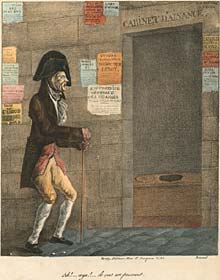French Caricature: Public Health–The Need Is Pressing
In the late eighteenth and early nineteenth centuries, the French promoted health as one of the natural rights of a citizen that the state bore the responsibility of supporting. This concept helped make France a leader in both public health theory and reform until the 1830s. Instead of appointing health boards that were disbanded once a specific medical emergency had been met, the French instituted permanent health institutions after the turn of the century. The Paris Health Council, established in 1802, was eventually joined by provincial councils, all of which were supposed to be permanent bodies although some did not function that way. The French were also leaders in collecting and analyzing statistical data. The French hospitals, army recruitment records, and city accounts provided sources for raw data. Many of the public health problems or their proposed solutions were not new, but the statistical information, generally comparative mortality rates and disease rates, did provide a scientific basis for the reformers’ arguments.20
The immigration of poor, sometimes sick people into urban areas with inadequate housing, water, and sewage disposal created public health difficulties in major cities in the United States and Europe in the nineteenth century. Although public latrines were uncommon in early nineteenth-century Paris, they were not unprecedented. Regulations were made against public urination and defecation, but historian Ann F. La Berge writes,
Nineteenth-century Parisians were in the habit of using any area of the city as a latrine. Urinating and defecating in gutters, on sidewalks, in streets, on buildings, and off bridges into canals and the river were common practice, to the chagrin of many hygienists. In fact, there was little practical alternative when one was away from home, for public conveniences were few. The only mention of public latrines in Paris dates from an 1817 health council report… 21
Hygienists proposed increasing the number of public latrines. A plan to construct 200 free latrines and urinals was promoted by the Parisian prefect of police in the early 1830s, but there is no evidence that either he or his successor accomplished this.22
In this print the artist successfully makes fun of both an obsession concerning bodily functions, particularly those associated with the gastrointestinal tract, and the upper class. As a man approaches the “Cabinet D’aisance” or the privy, the caption notes that his need is urgent. Signs, some legible and others not, are posted all around the entryway. There are advertisements for a purgative powder by Doctor Leroy, moveable odorless pits or toilets, and pumps for bad smells. Another poster dedicates a poem in twelve verses, “The Art of Evacuating,” to the Faculty of Medicine of Paris. The sign regarding the history of the low countries, refers to Belgium and Flanders, but also is a pun on the lower abdominal regions of the body. There are notices for the art of loving, septic drainage, a course of chemistry, and an essay on the urinary tract. The sign offering dinner for the cheap price of 18 sous might imply that the customer will also desperately need the outhouse after dining. The “Foire de St. Cloud” notice mocks the royalty who maintained a residence at Saint-Cloud. Foire can be translated as a fair or market, but more significantly given the sign’s position outside a privy, another meaning for foire is diarrhea. An additional gibe at the upper class is the poster that declares, “down with the wigs,” since hairpieces were worn by the wealthy and powerful.
